


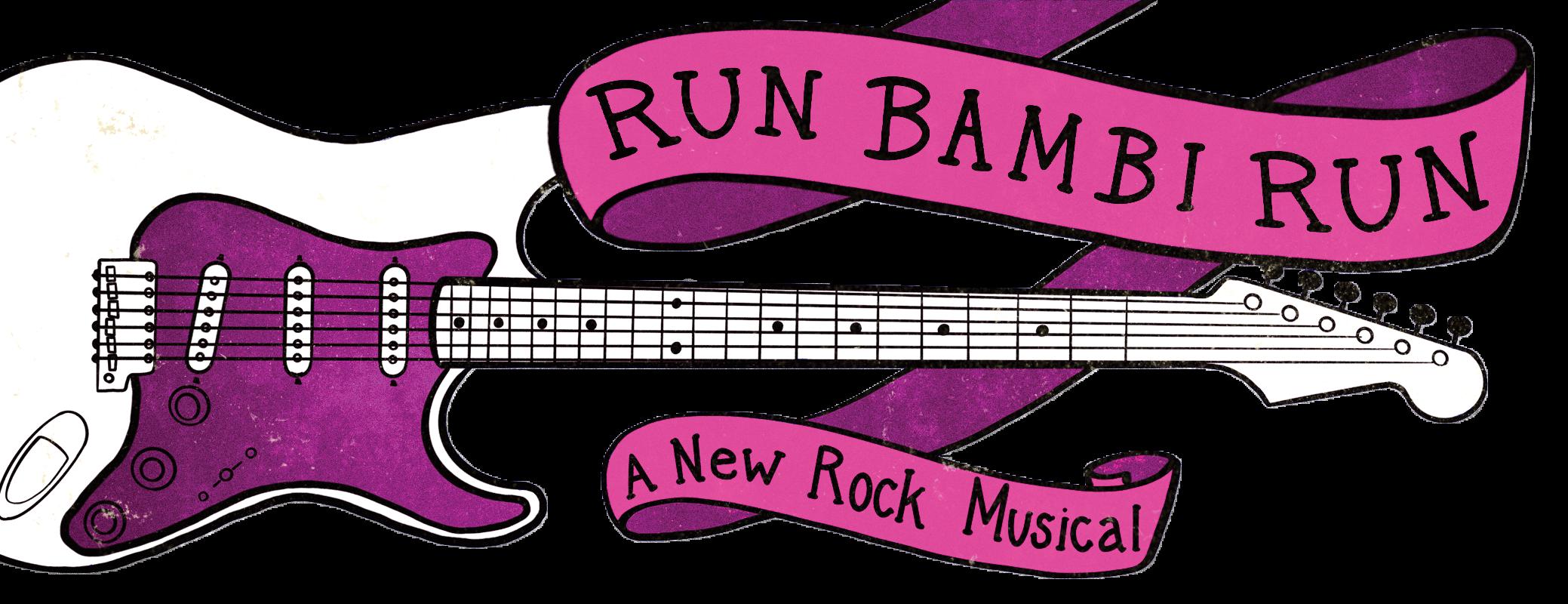







Run Bambi Run begins at Tracks Tavern, a local bar on New Year’s Eve 1979, where the ensemble shares a beer and brings the audience into the world of Laurie Bembenek’s sensationally tragic tale. The ensemble plays all the many characters in Laurie’s story and brings to life the rock sensibilities of this new musical.
Laurie recalls memories of her childhood, noting that she was a “tomboy,” but was often harassed for her beautiful appearance. She grew up close to her parents, especially her father, a former MPD police officer who resigned due to the noted corruption on the force. Laurie decides to follow in her father’s footsteps and become a police officer, against his warnings.
Laurie once again experiences harassment and sexism during her days at the Academy and also once she joins the police force, losing her job very shortly after being instated. In the meantime, Laurie meets a fellow cadet named Judy who becomes her roommate and friend, and eventually a key to her undoing. After Judy and Laurie find themselves jobless, they spend a short time working at the Playboy Club in Lake Geneva.
Laurie is determined to fight her firing; she and Judy meet a man who has photos of other MPD officers doing much more scandalous things without recourse. Laurie wants to use these photos for fuel for her case and visits a lawyer. In the meantime, she meets Detective Fred Schultz, forms an instant attraction, and begins a relationship and abrupt marriage.
As she continues to fight her dismissal, Laurie finds herself amongst an interesting cast of characters, from her best friend’s drug dealer boyfriend to her husband with the wandering eye to his ex-wife who is dating his ex-partner.

One night, Fred’s ex-wife, Christine, is found murdered and suspicion turns towards Fred, but ultimately Laurie is charged with the crime. Laurie proclaims her innocence even as she is put on trial, convicted, and sent to prison. The sensational nature of the intertwined relationships, Laurie’s physical beauty, and the shocking crime makes for a media frenzy.
As the years pass with Laurie in prison, she is denied appeal after appeal, and decides to take drastic action. With the help of her lover, Nick Gugliatto, Laurie escapes and goes on the lam, fleeing to Canada. After several months, the two of them are apprehended. Canadian authorities negotiate for a new hearing based on the inconsistencies with her original case and Laurie pleads to new charges that will allow her to go free.
Laurie’s life continues on filled with tragedy and she never truly escapes her legacy, waiting for justice that never comes. Did she do it? Was she framed? Was it a police cover-up? Just bad detective and legal work? Did the media taint her case? Laurie and her allies continue to ask these questions and Laurie never again gets to be just a Polish-American girl from Bay View.


At the first rehearsal for Run Bambi Run, Mark Clements said, “Of all the things in theater you can do, new work is the hardest. And new musicals are the hardest of all.”


From Les Misérables and Into the Woods to new favorites like Hamilton and Hadestown, musicals have long held a special place in our hearts. But while it can seem that these shows just arrived onstage complete with engaging books and sing-along songs, they all began as untested new works. The reality is that getting musicals from idea to stage is a very complicated business. Run Bambi Run’s journey to the Quadracci Powerhouse Stage is a great example of how much time, energy, resources, and collaboration are needed to bring such a behemoth piece of art to life.


Run Bambi Run’s inception began in the fall of 2011 when Milwaukee Rep produced the Green Bay Packers play Lombardi by Milwaukee-native Eric Simonson. Keen to make new play development part of Milwaukee Rep’s programming, Clements reached out to Simonson to do a brand new commission. When asked what he might be interested in writing about, Simonson mentioned a local story he’d been fascinated by: the stranger-than-fiction tale of Lawrencia “Bambi” Bembenek.
“Run Bambi Run?” Clements asked. Despite living almost 4,000 miles away at the time of the infamous murder of Christine Schultz, Clements had heard of Lawrencia Bembenek and the sordid details of her case. Now living in Milwaukee, he was excited about bringing the local story to the stage.
He told Simonson that it felt like it should be a musical, an “irreverent rock show in the vein of Bloody Bloody Andrew Jackson and Hedwig and the Angry Inch.” Simonson agreed; when asked who he’d want to do the music, he said without hesitation, “the Violent Femmes.”
The Violent Femmes are certainly known globally. But as the band was “discovered” by The Pretenders in 1981 while busking outside their show at Milwaukee’s Oriental Theatre, many Wisconsinites claim the band as their own. Ergo, a perfect partner for such a local story.

It took some time, but eventually Clements and Simonson got in touch with lead vocalist and guitarist Gordon Gano, who was excited about joining the project. However, he didn’t want to shoehorn Violent Femmes songs into the musical, instead offering to write original music for the story. And so, the work began.


After Milwaukee Rep issued a commission, the first draft of the play was completed in December 2017. Simonson and Gano worked on numerous drafts over the following years, interspersed with feedback from the artistic team and long conversations about everyone’s questions, ideas, and thoughts on next steps. Comparing the first and final drafts, song lyrics and dialogue saw major change over the years. But much of the show’s structure and song concepts have stayed the same, meaning the writers’ original impulses for how to tell this story were spot on.


The workshop process is an essential step for new play development. It’s an opportunity for the writers to hear the work out loud, get feedback from more artists, and learn how the piece moves and feels in real time and space.
In October 2018 and April 2019, Milwaukee Rep held the first workshops. Hearing actors tackle the script taught the team a lot about the show’s tone, pace, and structure. The creative team met again in September 2021 for a script



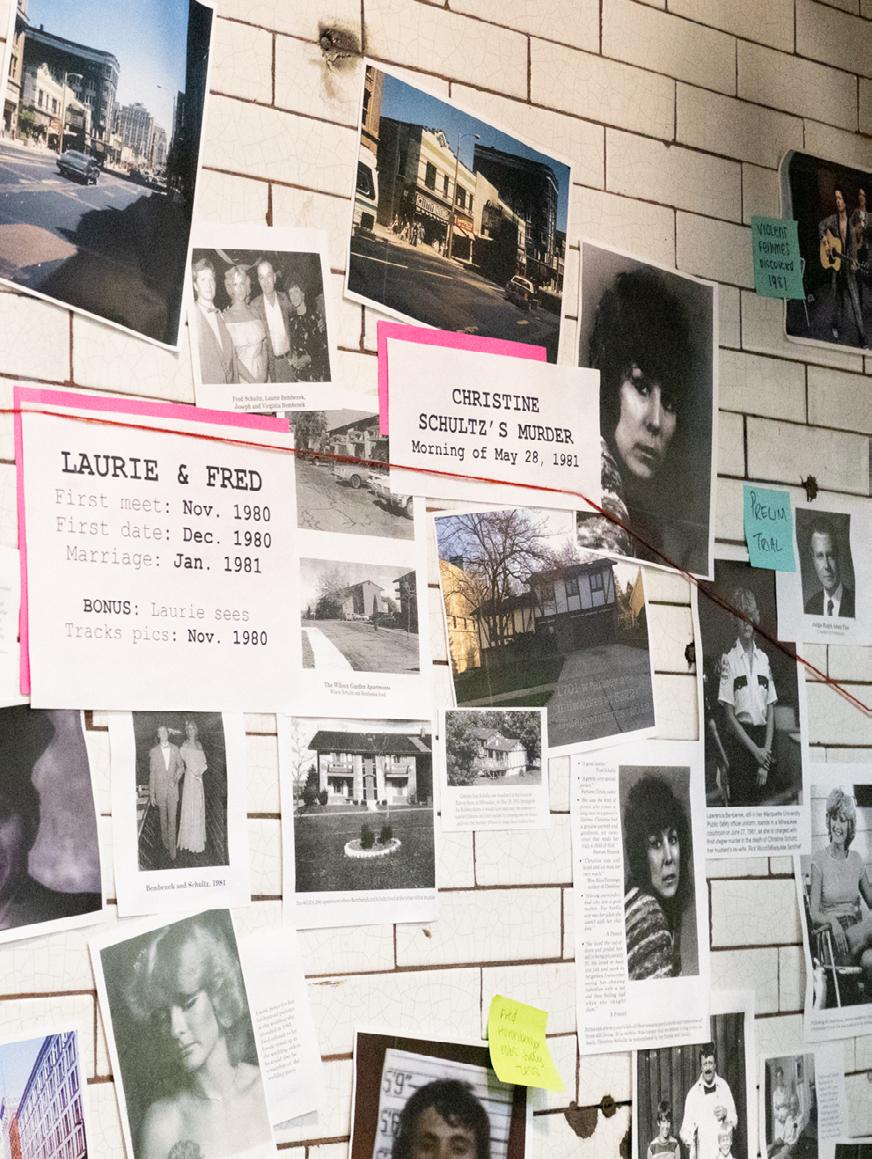
work session, spending a long weekend digging deep into the story, page-by-page. The biggest question that came from the time together was: Can this be an actor-musician show?

In many of our Powerhouse musicals, we have actors singing the show and a separate band playing it. It’s often only in our Stackner Cabaret that you see the actors singing and playing instruments. But could this show work if the band and the cast were one and the same? It was time to find out.
In July 2022 we hosted a music-focused workshop. Music director Dan Kazemi arranged and orchestrated a number of songs for the actors, we gathered in a room with dozens of instruments, and we got to work. Through this workshop we learned that not only was it possible to have the actors also playing the music, but that it really uplifted the show’s conceit of a group of narrators gathering to bring this true crime story back into the spotlight.
Our final workshop in May 2023 allowed the team to hear the entire piece read and sung-through from beginning to end. This work was crucial for understanding how the show played as a whole, and for working through details like duration, balance of music and book, and character doubling. Oh, did we mention that we planned on having 12 actors playing over 70 roles?
Leading up to the show, the entire creative team was in work mode, doing research, prepping music materials, starting to sketch staging ideas, and more. In August of 2023, we began rehearsals. Additional rehearsals and previews were essential for getting a show of this scale produced, and collecting essential feedback from designers and audience members in the process.
Now that the world premiere of Run Bambi Run is off and running, what’s next? Well, the hope is that producers and other theater-makers will hear about or come see the show and want to extend its production life, bringing it to their own theaters. Though the story is set in Milwaukee, the real life event caught global attention, and the themes of the (in)justice system, patriarchy, gender roles, and true crime feel relevant to audiences all over.
As Clements said, creating new plays is hard work. But worth every minute.
Laurie’s cellmate at Taycheedah, Nick’s sister




Kelly’s brother and Laurie’s love interest

head instructor at the MPD Academy
body builder, ex-con, pot dealer who gets Judy involved in his business while they are in a romantic relationship
fellow woman recruit to the Academy and Laurie’s roommate and supposed friend
Milwaukee A.D.A. involved in the trial

private investigator who fights for Laurie’s innocence
Gale a reporter who follows Laurie’s case
judge who presides over Laurie’s trial
Laurie’s hot-shot lawyer
“Bambi,” the protagonist musical and murder


Run Bambi Run is a fictionalized story based on real life events. Some of the characters are based on real people, some are composites of several different people, and some are completely fictional. All the characters have been dramatized for the stage.


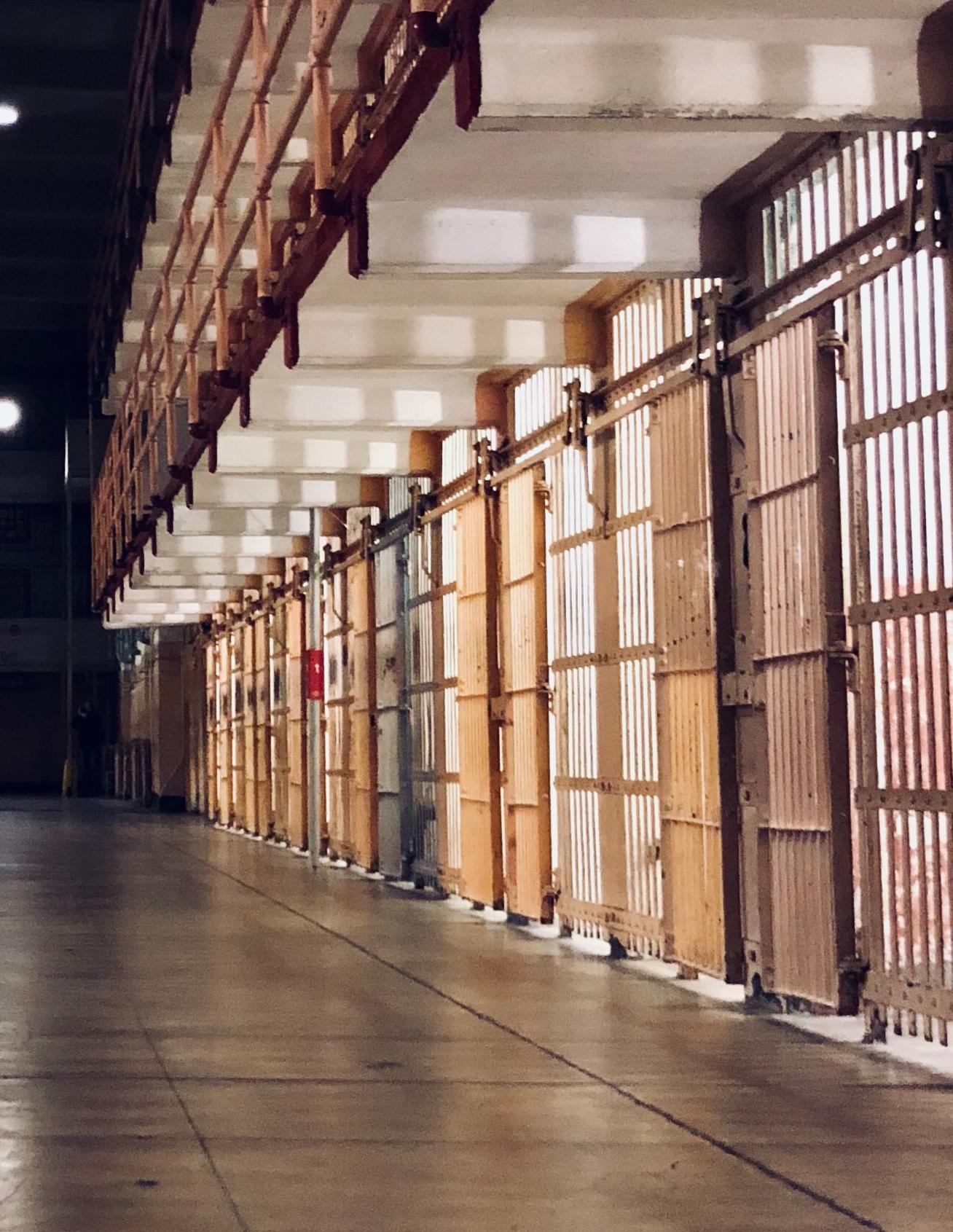
an old-school, “law and order” leader who tries to keep the white, male power structure in place in the MPD and Milwaukee
Laurie's Mom
Fred’s former partner and Christine’s boyfriend
Laurie’s husband who is an MPD Detective


Fred’s ex-wife and mother to Shannon and Sean




Fred and Christine's son
mysterious Milwaukee local with ties to Judy and Fred


1982 - 1990: Laurie files multiple appeals that are denied.
September Private investigator Ira Laurie’s case and joins

june 19, 1984: Laurie and Fred’s divorce
October Laurie
April
August 15, 1958: Lawrencia Bembenek is born in Milwaukee.
March 1980: Laurie begins training at the Milwaukee Police Academy
May 1980: Judy arrested for smoking marijuana at a concert.
Summer 1980: Laurie graduates from the Police Academy.
August 25, 1980: Laurie dismissed from Milwaukee PD (supposedly in connection with filing a false report connected to Judy’s arrest).
Summer/Fall 1980: Laurie meets Detective Fred Schultz.
November 1980:
Fred and Christine’s divorce is finalized.
june 28,1983: Laurie files for divorce from Fred.
March 9, 1982: Laurie is convicted of murder and sentenced to life in prison.
February 23, 1982: Laurie’s trial commences.
November 1981: Laurie and Fred get remarried because their first wedding was nullified for not waiting the required six months after finalizing his divorce.
June 24, 1981: Laurie is arrested for Christine’s murder.
May 28, 1981: Christine Schultz is murdered.
January 1981: Laurie and Fred marry.
December
September 1984: Ira Robins hears about joins her defense.
1984: is granted.
October 17, 1990: Nick are arrested in Canada.
April 22, 1991: Laurie voluntarily returns to the U.S.
December 9, 1992: pleads no contest to second-degree instead of risking another conviction. sentence is commuted to time served.
1992: Woman on Trial, Laurie’s memoir, is published.
1993:
Laurie has an exhibition of her early paintings at UW-Milwaukee.
July 15, 1990: Laurie escapes Taycheedah Correctional Institution and goes on the lam with Nick Gugliatto.
November 20, 2010:
Laurie dies of liver and kidney failure in a hospice facility.
June 2008:
Laurie's appeal is denied.
April 2008:
Laurie petitions the U.S. Supreme Court for a reversal of her seconddegree murder conviction.
2007:
Laurie and Marty get divorced.
2005:

Laurie marries Marty Carson.
2002:
1996: Laurie moves to Washington state to be near her retired parents.
Laurie falls or jumps from a hotel window while sequestered for the Dr. Phil show, causing her leg to be amputated.
Laurie’s story has captivated people from the media and the public since her initial case. If you want to explore more about her story and the case, there are lots of ways to engage.
Woman on Trial (1992) by Lawrencia Bembenek Run, Bambi, Run (1992) by Kris Radish Run, Bambi, Run podcast City Confidential Milwaukee: The Legend of Bambi Bembenek (A&E special, 2002)
The Perfect Murder: Deadly Divorce (2015) Investigation Discovery On the Case with Paula Zahn: Bambi Is Captured on Investigation Discovery
Vanity Fair Confidential: Was Bambi Framed? (2018) Investigation Discovery
POPULATION (1980): 636,295

POPULATION DECLINE (1970 - 1980): 11%
NATIONAL MEDIAN HOME PRICE (1980): $47,200
ETHNIC DEMOGRAPHICS:
WHITE (71.4%)
AFRICAN AMERICAN (22.9%)
HISPANIC (4.2%)
AMERICAN INDIAN (0.8%)
ASIAN/PACIFIC ISLANDER (0.7%)
25.8% OF MILWAUKEE RESIDENTS IN THE WORKFORCE WORKED IN THE MANUFACTURING SECTOR IN 1980 .
77% OF METRO AREA RESIDENTS LIVING BELOW THE POVERTY LINE LIVED IN THE CITY OF MILWAUKEE IN 1980 .
WHEN LAURIE LOST HER JOB IN AUGUST OF 1981 , THE WISCONSIN UNEMPLOYMENT RATE WAS 7.6% .

RONALD REAGAN WAS ELECTED PRESIDENT OF THE UNITED STATES IN 1980 .

LARRY SHUE'S THE NERD PREMIERED AT MILWAUKEE REP IN 1981 , SIX YEARS BEFORE ITS ARRIVAL ON BROADWAY.

IN 1982 , THE BREWERS MADE THEIR ONLY APPEARANCE IN THE WORLD SERIES .

FRANK BALISTRIERI , THE HEAD OF THE MAFIA IN MILWAUKEE, WAS CONVICTED AND IMPRISONED ON SEVERAL CHARGES IN 1984 .

MAYOR HENRY MAIER 'S 28-YEAR TENURE (STARTED IN 1960) ENDED IN 1988 .

IN AUGUST OF 1981, THE VIOLENT FEMMES WERE "DISCOVERED" BY MEMBERS OF THE PRETENDERS WHILE BUSKING ON A STREET CORNER IN FRONT OF THE ORIENTAL THEATRE.

THEY WERE THEN ASKED TO PLAY AN ACOUSTIC SET AFTER THE OPENING ACT AT THE PRETENDERS' CONCERT THAT EVENING.


Lawrencia Ann Bembenek, the third daughter of Joe and Virginia Bembenek, was born on August 15, 1958 in Milwaukee. Her father had been an officer with the Milwaukee Police Department, but resigned after experiencing corruption of which he disapproved. Laurie was raised Catholic and attended several parochial schools, then transferred to Bay View High School, graduating in 1976.
Upon graduation, Laurie attended a community college in Virginia Beach where she earned a degree in fashion merchandising management. After completing college, Laurie worked in retail and modeling, appearing in a Schlitz calendar in 1978. Wanting to follow in her father’s footsteps, Laurie enrolled in the Milwaukee Police Academy in March of 1980 where she faced significant discrimination because of her gender, but still graduated sixth in her class. Laurie went on to a position with the MPD, but was terminated after less than a month on the job.

After her firing, Laurie sought to fight her termination, approaching the Equal Opportunity Employment Commission for assistance with photographs of other officers committing much more serious infractions. During this time, Laurie briefly worked as a waitress at the Playboy Club in Lake Geneva to make ends meet, but later worked as a trainer at a health club, and then a security guard at Marquette University.
During this time, Laurie met the recently divorced Detective Fred Schultz, who quickly became Laurie’s new husband. Just a few months after their marriage Fred’s ex-wife Christine was murdered. Laurie was arrested for the crime less than a month later. Her trial commenced in the spring of 1982. Despite mostly circumstantial and inconsistent evidence and a weak case against her, Laurie was convicted of first-degree

murder and sentenced to life in prison. Laurie's trial was sensationalized because of the nature of the crime, her beauty and personal history, and complicated connections between the various parties involved.
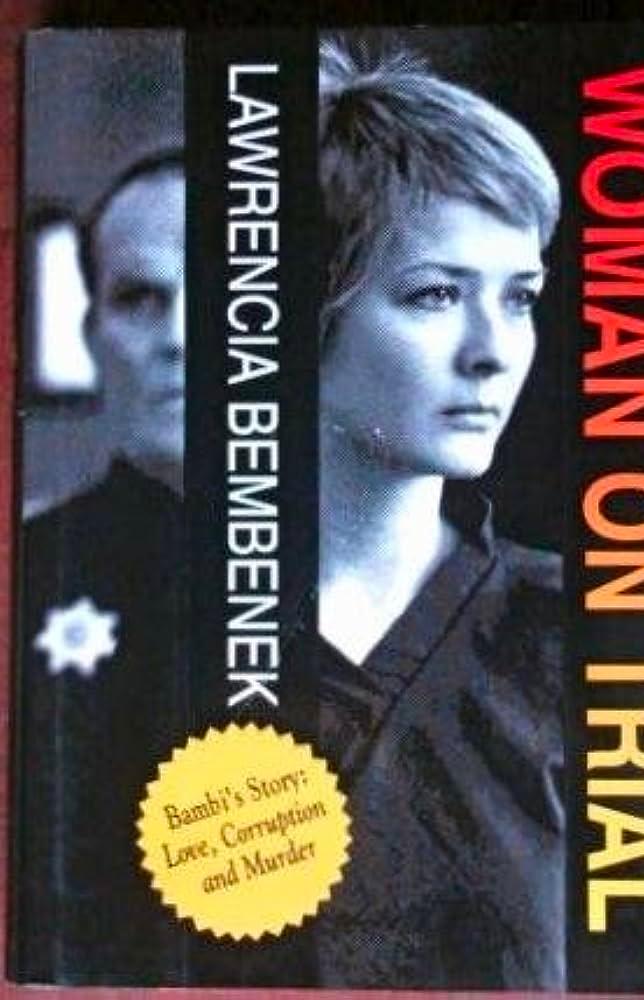

Laurie continued to insist that she was innocent, pursuing multiple appeals and other avenues to seek her freedom over the years. In 1990, Laurie escaped from prison with her beau, Nick Gulgiatto, and fled to Canada. After several months on the run, they were captured and Laurie was returned to Wisconsin, but was able to plead “no-contest” to second-degree murder and was released for time served. Her life after prison was not an easy one. She wrote a book about her experiences published in 1992, which was later made into a television movie. Laurie moved to Washington state to be near her parents, and eventually met her second husband, Marty Carson. Laurie suffered from PTSD, alcoholism, and hepatitis C, as well as having a leg amputation due to a major injury in the early 2000s.
Laurie returned to a childhood passion of art, painting and having several exhibitions of her work. She led a quiet life in the Pacific Northwest, but continued to contend that she was innocent, petitioning the Supreme Court to look at her case, working with PI Ira Robins to clear her name, and seeking a pardon from the Wisconsin governor. When she died in 2010 of liver and kidney failure at the age of 52, her pardon had not come.
Laurie Bembenek was treated differently by the media because of her physical appearance, but she is just one of many women who have suffered at the hands of the media and our society’s desire for women to have “likability” or conventional beauty.
Bembenek’s portrayal in the media was often tainted by her beauty and society’s expectations for a woman’s behavior. She was painted as immoral, but also inaccessible during much of her trial and time in the spotlight. Bembenek’s strength and seriousness were seen as detrimental, with the public and the media expecting her to be more demure, quiet, and conventional. Her incredibly short stint as a waitress at the Playboy Club was highlighted, as well as her one appearance on a calendar in her younger years. Even the nickname “Bambi,” which Bembenek grew to hate due to the media’s exploitation of the moniker, comes from a demeaning and patronizing place.

Her appearance and personality also impacted her career, as the powersthat-be in the Milwaukee Police Department harassed her, discriminated against her, fired her, and ultimately failed her in so many ways. Bembenek was set up to fail simply for existing as a woman in a traditionally male space.
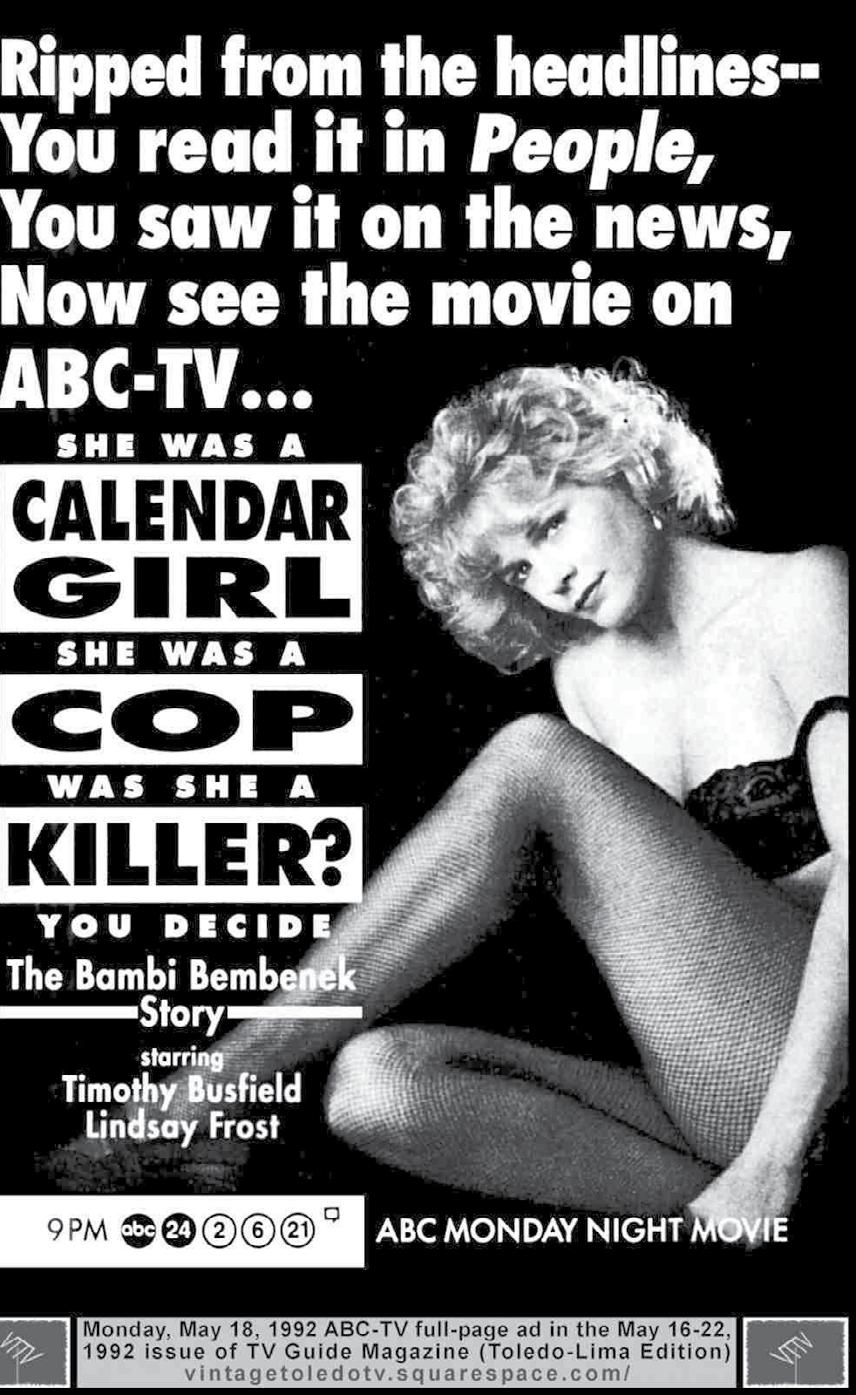

Research, published in the Journal of Applied Social Psychology, suggests that it’s not holding a leadership position that leads to a likeability problem for women in male-dominated jobs. Instead, it’s more about how women obtained the leadership role. If the woman got a lucky break or was assigned to her position and wasn’t actively pursuing the role, then she will be liked more. However, women who are seeking the leadership role and are motivated to work hard to pursue their goals are considered to be breaking gender stereotypes that suggest women shouldn’t seek power, especially in roles typically held by men. These are the women most likely to face the likeability problem.
 - Kim Elsesser, Forbes
- Kim Elsesser, Forbes
Bembenek is far from the first or last woman to be vilified for her appearance or her “unlikable” personality, especially in the public eye. Cultural critic Roxane Gay says, “In many ways, likability is a very elaborate lie, a performance, a code of conduct dictating the proper way to be.” Laurie, and other women who defy cultural expectations and norms, have often been the target of attacks and unfair treatment in both the media and their lives.
“So much garbage has been written about me and how I look, as if that’s all there is.”
-Laurie Bembenek, Woman on Trial
A major part of Laurie’s story centers on the corruption and other issues within the Milwaukee Police Department. Her father and her later ally, Ira Robins, both stated that they left the force due to corruption they witnessed. Laurie encountered it first-hand in her own experiences with the MPD.

Since its founding in 1855, the MPD has faced many controversies and its fair share of scandals, allegations of corruption, injustice, and discrimination. During Laurie’s brief time with the Milwaukee Police Department, she experienced the gendered discrimination and harassment that was a hallmark of that era. As seen in the musical, Laurie encountered sexual harassment, inappropriate behaviors, gender prejudice and discrimination, and ultimately, illegal labor practices connected to her status as a woman.
Laurie entered the Academy and served under Police Chief Harold Breier, one of Milwaukee’s longest tenured leaders of the MPD. Breier was known for his “law-and-order” approach, his intimidation of those who would question his policies, his opposition to civil rights, and his racist views and policies. He opposed the Civil Rights Movement and put NAACP Youth Council members under surveillance, condoned physical violence against protestors, and opposed the integration of Milwaukee Public Schools. Under Breier, minority and women recruits were often harassed and forced out of the department or terminated like Laurie. Breier’s dedication to white male power in the MPD and the city itself was unwavering, and his own biases impacted the department and Milwaukee at the time and to this day.
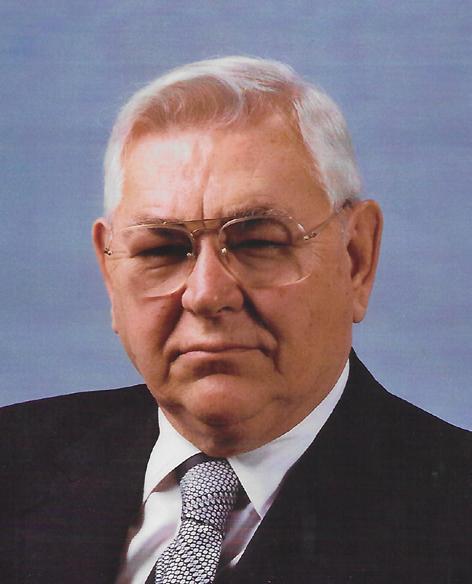
Laurie tried to bring this discrimination and injustice in the MPD to light after her firing, but her subsequent arrest and conviction put her earlier case on the backburner. Some, including Laurie herself, have speculated that some of what she experienced, both in her termination and her later
trial, were the result of the department wishing to quash her speaking out. Laurie’s original infraction that led to her firing was related to her role in supposedly filing a false report in connection to Judy Zess’s arrest for marijuana possession. Laurie uncovered photographs of multiple MPD officers participating in a competition in which they cavorted naked or barely clothed in a public space. One of her major arguments against her firing in light of this information was the severity of others’ infractions that were ignored or condoned by the powers-that-be such as engaging with prostitutes, drinking and sleeping on the job, behaving inappropriately in public, and other violations of policy.
As Laurie faced murder charges, the possibility of corruption or injustice related to her case became a key factor. Run Bambi Run refers to some of the inconsistencies and fabrications that led to Laurie’s conviction; after years of investigations and further review, the possibility of mishandling of the evidence, witness tampering, bias, and other factors also came to light. Not to mention the conflicting and intertwined relationships in Laurie’s life with various members or former members of the MPD.
While Laurie experienced bias and discrimination based on her gender and her appearance, the most insidious examples of issues with the Milwaukee Police Department center around law enforcement and the Black community. Going back to its very inception, but rising in prevalence during the Great Migration, MPD’s role in one of America’s most segregated cities has been fraught. MPD has clashed with protestors for many years and during many social justice movements, MPD officers have committed acts of violence or murder upon Black citizens, and the MPD has contributed to Milwaukee’s de facto segregation.
As the MPD found itself coming out of the Breier leadership era, it had to grapple with the legacy those years left behind. It is still grappling with its legacy, its role, and its power to change our community. Efforts such as increased community policing programs, crisis intervention training for all officers, neighborhood-based districts, and other initiatives hope to restore trust in the MPD and make officers partners, not antagonists, in the Milwaukee community.


While the intersection of the true crime genre and musical theater seems an odd partnership, Milwaukee Rep’s Run Bambi Run is one in a long legacy of musicals inspired by real crimes and the scandals surrounding them.
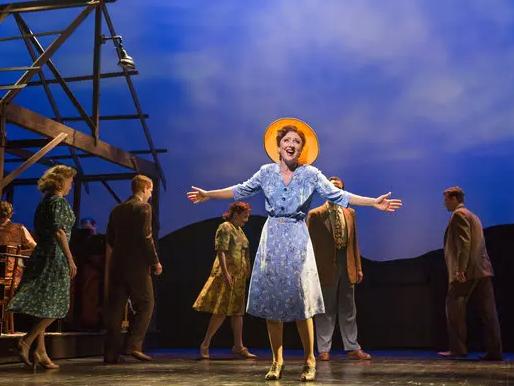

According to historian Peter Haining, Todd was a barber in the late 1700s who started murdering after a customer described a dalliance with a woman who sounded like Todd’s own partner. He then went on to kill wealthy customers and form a partnership with his pie-maker neighbor. Todd was caught and hanged in 1802.
The infamous criminal duo are two of the most notorious in American history and the musical follows their exploits and their love.
Based on a 1926 play of the same name, Chicago was inspired by two true murders that took place in the 1920s. The two women who were suspects in the trials met in Cook County Jail and battled for tabloid headlines at the time.
Following the story of Leo Frank, a Jewish factory manager in 1910s Georgia, this musical portrays his arrest, conviction, imprisonment, and lynching for an alleged murder and assault of a young factory worker. The musical deals with antisemitism, corruption, miscarriage of justice, and the beauty of the love connection between Frank and his wife Lucille.


After returning from WWII, Mel Brooks worked for a shady theatrical producer who romanced wealthy older women for funding. Brooks also observed the financially dishonest practices of many other producers and these factors, combined with his belief that laughing at monsters like Hitler took away their power, led to the beloved classic musical comedy.

Using the frame of a carnival game, Assassins tells the stories of people who have attempted to assassinate American presidents. The musical imagines the nine assassins not only in their own eras and stories, but in a fictional world where they interact with each other.

Based on a 1902 incident where a Missouri farmer found a baby thrown from a train, the musical supposes one fictional reason behind the crime.
The musical, inspired by a film, inspired by a novel, inspired by a true story, follows a young man who murders his way to a title. As the story evolved, the characters and locations changed, but the use of murder as a tool to gain advantage remains.
Milwaukee Repertory Theater is located in the Associated Bank Theater Center which is part of the Associated Bank River Center downtown at the corner of Wells and Water Streets. The building was formerly the home of the Electric Railway and Light Company.
The Ticket Office is visible on the left upon entering the Wells Street doors. The Quadracci Powerhouse is located on the Mezzanine and can be accessed via escalator or elevator.
Financial support enables The Rep to:
Advance the art of theater with productions that inspire individuals and create community dialogue.
✯ Advance the art of theater with productions that inspire individuals and create community dialogue;

✯ Provide a richer theater experience by hosting Rep-in-Depth, TalkBacks, and creating PlayGuides to better inform our audiences about our productions;
Provide a richer theater experience by hosting Rep-in-Depth, TalkBacks and creating PlayGuides to better inform our audiences about our productions.
Maintain our commitment to audiences with special needs through our Access Services that include American Sign Language interpreted productions, captioned theater, infrared listening systems and script synopses to ensure that theater at Milwaukee Rep is accessible to all.
✯ Educate over 21,000 students at 150+ schools in the greater Milwaukee area with Rep Immersion Day experiences, student matinees, workshops, tours and by making connections with their school curriculum through classroom programs such as Reading Residencies;

✯ Maintain our commitment to audiences with special needs through our Access Services that include American Sign Language interpreted productions, captioned theater, infrared listening systems and script synopses to ensure that theater at The Rep is accessible to all;
Educate over 20,000 students at 200+ schools in the greater Milwaukee area with Rep Immersion Day experiences, student matinees, workshops, tours and by making connections with their school curriculum through classroom programs such as Reading Residencies.
✯ Educate the next generation of theater professionals with our EPR Program which gives newly degreed artists a chance to hone their skills at The Rep as they begin to pursue their theatrical careers.
We value our supporters and partnerships and hope that you will help us to expand the ways Milwaukee Rep has a positive impact on theater and on our Milwaukee community.
Educate the next generation of theater professionals with our EPR Program which gives newly degreed artists a chance to hone their skills at Milwaukee Rep as they begin to pursue their theatrical careers. We value our supporters and partnerships and hope that you will help us to expand the ways Milwaukee Rep has a positive impact on theater and on our Milwaukee community.
4 1 4-290-5376
MILWAUKEE REP RECEIVES SUPPORT FROM: The Lynde and Harry Bradley Foundation
The Lynde and Harry Bradley Foundation
The Richard & Ethel Herzfeld Foundation
The Richard & Ethel Herzfeld Foundation
The Shubert Foundation